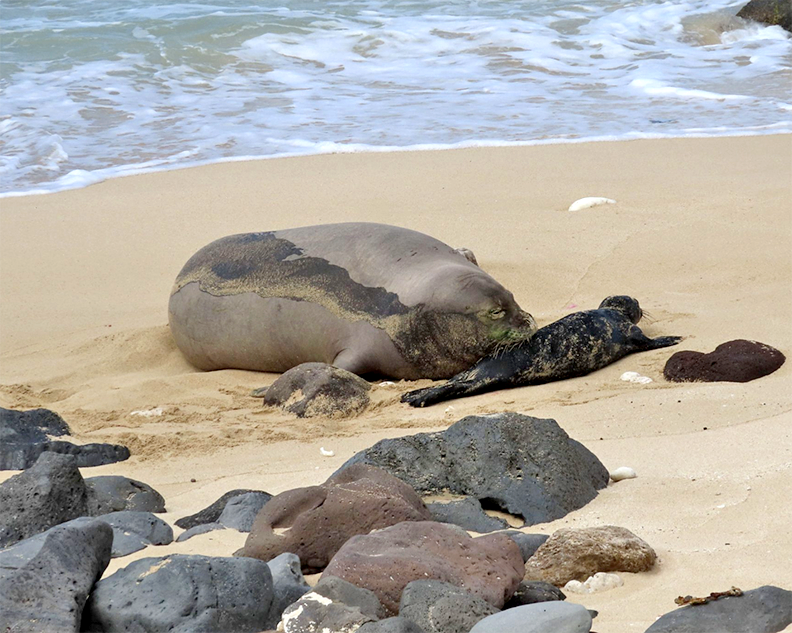By Léo Azambuja

Kalalau, right before sunset in late August. Photo by Léo Azambuja
Kalalau Trail reopened June 17, after about 14 months of closure due to the record rainfall and flooding on April 14, 2018. Since the reopening, I’ve hiked to Hanakapi‘ai Falls and kayaked to Kalalau Beach.
I must say, the new end of the road is a lot better now.
Given the monumental punishment Mother Nature inflicted on North Shore’s landscape and roadways, the state and county governments made a nearly miraculous effort of reopening the highway past Waikoko and the Kalalau Trail in a little over a year.
Before the storm, the situation at Ke‘e Beach had been a continuous storm in itself for years, with a parking lot impossible to find a spot, and an overcrowded beach. The trail to Hanakapi‘ai Beach looked like a busy airport terminal, resulting in mass overnight strandings on the other side of the stream whenever there was a flash flood, and also a string of deaths from people trying to cross the overflowing stream and from drowning at the treacherous and unguarded beach.
A couple hundred yards before Ke‘e, the state parking lot was full of potholes, and frustrated tourists would cut you off to score a parking spot (yep, I almost got ran over). Cars would be illegally parked alongside the road, and were occasionally slapped with parking tickets.
The unprecedented disaster of April 2018 and the long road to recovery gave government officials and community members time to figure out what to do with all that chaos that was destroying the essence of our island in one of its most beautiful places.
It does appear that with the restrictions in place at Ke‘e Beach, the county’s Ha‘ena Beach Park — the beach by the lifeguard stand near Tunnels — has had an increase in visitors. Finding a parking spot there can be quite a challenge. But for local residents who drive an hour to get there, and for visitors who plan for months to come here, I believe 10 minutes waiting for a parking spot is not too bad.
Ke‘e Beach, on the other hand, looks much different. The once-overcrowded beach is now nearly empty. Or at least that’s what it feels like. The amount of people hiking to Hanakapi‘ai Beach and Falls has reduced a lot as well, and the hike is much more enjoyable now. I don’t expect the visitation limits to end the deaths at Hanakapi‘ai (I hope it does, though), but I expect it will reduce the tragedies dramatically.
At Kalalau, the situation seems to be about the same as before the flood, more or less. I haven’t hiked there yet since the reopening, but I did take a kayak and spent four days there last month. So I can’t speak for the trail condition past Hanakapi‘ai Beach, but I did hear it is in good shape, despite a few scary parts. However, there were always a few scary sections, most notably at the infamous Crawler’s Ledge.
I arrived at Kalalau on a Sunday afternoon, and the campsite near the waterfall was just as crowded as in previous years. It was hard to find a safe camping spot in that area. My friend and I set up our tents on the mauka side of the trail, and we immediately saw a few rocks roll next to us, even though we were far from the cliffs. Someone decided to move his hammock from a prime spot facing the beach, and we moved there.
On the next day, mostly everyone in that area had left, and there were plenty of good spots. It always seemed to be that way in Kalalau; it would be full one day, and empty on the next.
There were some big rockslides down from the waterfall, and apparently near the cliffs toward Honopu‘u, which changed the landscape a little bit. The famous “Community Garden” deep in Kalalau Valley is quite overgrown, but there is an abundance of fruit hanging from trees. The feral cats at the campsite are all gone, and the birds now are the ones begging for food crumbs.
Aside from that, it looks like business as usual at Kalalau, with goats roaming the cliffs at dusk and dawn, people camping with and without permits, boats shuttling people for a good amount of cash, and people camping both in designated camping spots and in the cave down the beach.
I’m not here to judge what’s right or wrong. But after DLNR officers slapped me with a warning years ago for camping without a permit at Polihale Beach, I never camped anywhere without a permit anymore. It can be frustrating, especially at Polihale and Koke‘e because it’s not as easy as it used to be to secure permits there, but I would rather follow the law than pay for the consequences — a misdemeanor conviction and a $500 fine. I just wish DLNR would set aside a small number of permits for local residents only. My two cents.
Overall, great job to all who worked to make the end of the road a better place than it was before last year’s flood. Mahalo!
Discover more from ForKauaiOnline
Subscribe to get the latest posts sent to your email.




Leave a Reply